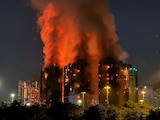- Volcano images from space were shared by ESA on August 24, marking Vesuvius' eruption date
- Mount Vesuvius erupted in 79 AD, burying Pompeii and Herculaneum under ash and pyroclastic flows
- Vesuvius has erupted over 50 times since 79 AD, most recently in 1944
From Italy's Vesuvius to Indonesia's Krakatoa, the European Space Agency (ESA) has shared stunning images of volcanoes taken from space. In a post on Instagram, the space agency wrote, "We live on an active planet." The pictures were shared on August 24 - a day in the year 79 AD Mount Vesuvius was believed to have erupted. It was one of history's "most famous natural disasters" as it buried the cities of Pompeii and Herculaneum under ash and pyroclastic flows.
Also Read | Passenger Lauds Air India Crew For Handling "Extremely Distressing" Medical Emergency Mid-Air
Mount Vesuvius is a famous active volcano located near Naples, Italy.
Photo Credit: Instagram: @europeanspaceagency / @NASA – @thom_astro
"According to tradition, on 24 August in the year 79 AD, Mount Vesuvius erupted in one of history's most famous natural disasters, burying the cities of Pompeii and Herculaneum under ash and pyroclastic flows," ESA said in the post.
"While most modern historians place the date later in the autumn, it remains a reminder of how powerful and unpredictable our planet can be."
As per recorded reports, the volcano has erupted over 50 times since then, with the last eruption occurring in 1944. Vesuvius is considered one of the most dangerous volcanoes due to its proximity to Naples and surrounding towns.
Also Read | Watch Dramatic Landing Of Hot Air Balloon On Narrow Street In UK
Tajogaite Volcano is a monogenetic volcano located in the municipality of El Paso on the island of La Palma, Canary Islands.
Photo Credit: ESA/NASA – T. Pesquet
Klyuchevskoy is one of the most active stratovolcanoes in Russia's northern Kamchatka Peninsula.
Photo Credit: ESA/NASA @astro_timpeake
"Today, astronauts aboard the @iss continue to photograph volcanoes across the globe, from Italy to Indonesia, capturing stunning views of these fiery features from orbit," the post added.
"Each crater, plume, and lava field is a reminder that Earth is alive, constantly reshaping its surface."
Mount Taranaki, officially Taranaki Maunga, is a dormant stratovolcano in the Taranaki region. It is on the west coast of New Zealand's North Island.
Photo Credit: Photo Credit: ESA/NASA – @astro_alex_esa
Krakatoa is an active Indonesian stratovolcano in the Sunda Strait, famous for its catastrophic 1883 eruption. It lies between the islands of Java and Sumatra.
Photo Credit: ESA/NASA – A. Gerst















